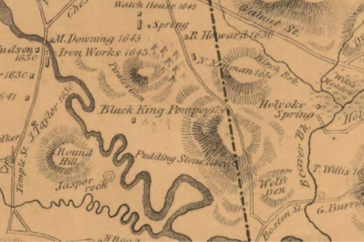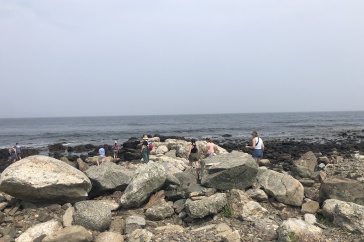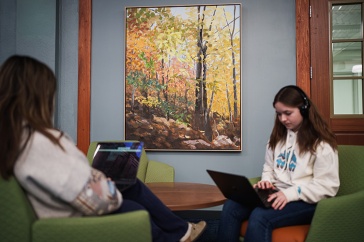If you walk down Academic Way in Durham, you’ll spot it a long way off: a bright mural covered in half-animal, half-human avatars of color. The patterned background echoes Mesoamerican designs. Layered among these elements are symbols of modern American life – emojis, cell phones, currency and eyes, either singly or in pairs, looking. On one side, there’s a prominent seal of the Office of Homeland Security. The colorful cartoon-like art evokes a playful, happy feeling but the juxtaposition of images tells a different story.

The digital art was created by Michael Menchaca, a Texas-based Latinx artist. Menchaca's design was chosen by the Committee for Campus Aesthetics after a nationwide call for submissions. It was installed on the exterior elevator tower of the Paul Creative Arts Center in August.
Menchaca’s art is grounded in a sense of place – their experiences as a Latinx person growing up in San Antonio, a city that sits on the edge of Mexico with a complicated colonial history within the context of Texas’s sovereignty battles. American cities across the Mexican border have colonial legacies that played out to the detriment of Brown people during Menchaca’s formative years; notably, they say, in the “War on Drugs” and through anti-immigration laws. These prejudices and inequalities continue today.
Menchaca’s art is also rooted in time. They grew up during the explosion of video games and loved them, despite recognizing at some point along the way that the games were full of white heroes defeating the Black and Brown bad guys, and the glorification of police violence.
At San Antonio College and Texas State University, and later at the Rhode Island School of Design, Menchaca studied graphic design and printmaking. They delved into mid-century cartoons and ancient Mesoamerican codices (Indigenous pictorial manuscripts). They worked with moving images such as slot machines and were influenced by Japanese video games.
Want to learn more about Michael Menchaca’s journey as an artist?
In this UNH presentation, Menchaca discusses influences and the ideas within Hope is a Discipline.
Menchaca's unique style developed from a desire to combine all these influences in a way that would say something much more than their individual meanings. The juxtaposition would take colonial legacies and capitalist culture and turn it on its head.
Hope is a Discipline, Menchaca’s mural at UNH, seeks to do just that.
“My personalized lexicon of animal archetypes and narrative pattern designs…assist in translating, preserving and mythologizing contemporary stories of social and economic inequality, racial prejudice, class discrimination and online surveillance practices,” says Menchaca.
The title of the piece looks to a future where these stories are transcended or transformed. The phrase “hope is a discipline” was coined by Mariame Kaba, a social justice activist, educator and organizer. Menchaca features her words prominently on the mural, suggesting that the viewer might hope for and work toward better conditions for Black, Indigenous and other people of color.
“My hope is that it [the work] brings students, faculty and visitors of the University to contemplate what the discipline of hope may entail in their own personal lives,” says Menchaca. “A lot of us are struggling now. It’s a pandemic…. It’s very easy to be pessimistic in this kind of environment…. But for us to try to survive, one has to have that discipline of remaining hopeful and doing things for each other, raising each other up and not seeing one another as competitors but as partners.”
This mural is funded by UNH’s Coe-Hall Fund.

-
Written By:
Susan Dumais '88 '02G | College of Liberal Arts

















































